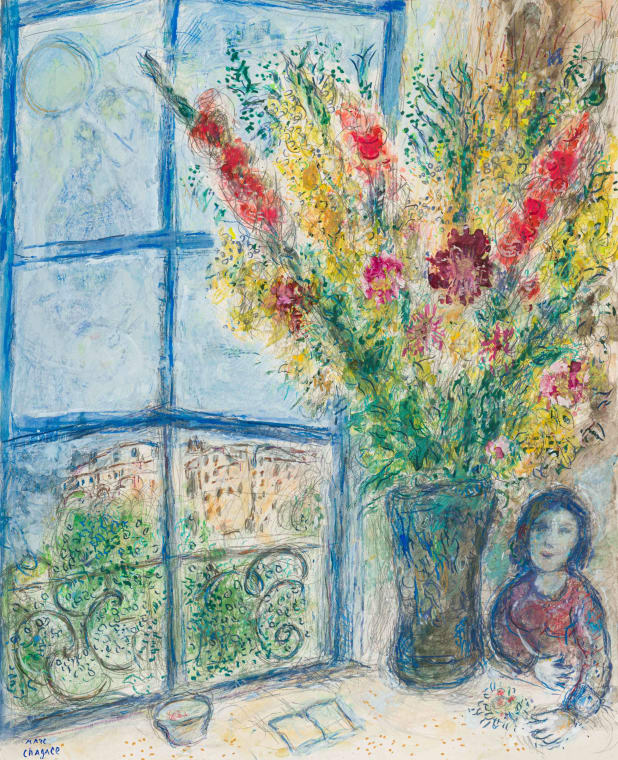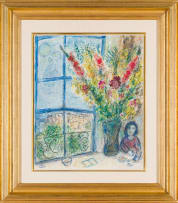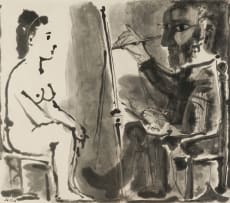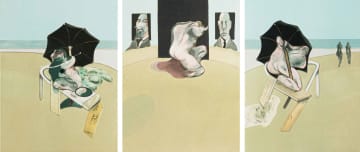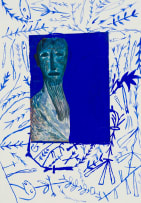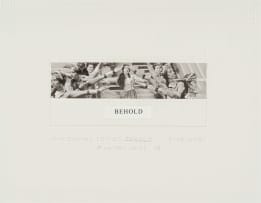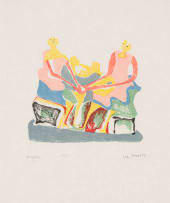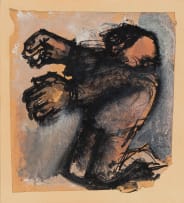The International Sale
Live Virtual Auction, 22 October 2024
Evening Sale
Incl. Buyer's Premium & VAT
About this Item
signed; inscribed DE399 on the reverse of the sheet; inscribed with the artist's name, dated 1974, the title 'Paris Window' and medium on a Gallerie Gmurzynska label adhered to the reverse
Notes
Accompanied by a certification by The Comité Marc Chagall, no. 96022, dated 10 March 1996.
Accompnaied by a copy of a Les Art International certificate of authenticity, dated 10 November 1999 and an invoice dated 29 October 1999.
Accompanied by valuation certificate from Berkeley Square Gallery, signed by Peter Osborne.
Marc Chagall occupies a distinctive and somewhat singular position in the canon of modern art. While many of his contemporaries, such as Picasso, Matisse, and Kandinsky, leaned towards formal abstraction or intense
experimentation with form and structure, Chagall remained deeply rooted in figurative representation, albeit through a dreamlike and fantastical lens. His work, often described as poetic or lyrical, transcended the rigid boundaries of artistic movements like Cubism, Fauvism, and Surrealism, blending elements of each into a style uniquely his own. Chagall's embrace of vivid, expressive colour, alongside his deep connection to folk art, religion, and his personal cultural heritage, placed him somewhat outside the central debates of modernism, which were often focused on the reduction of form and the breaking of pictorial traditions.
However, his resistance to pure abstraction did not distance him from the heart of modernism. Chagall's exploration of memory, emotion, and the metaphysical closely aligns with modernist themes of inner consciousness and subjective reality. His ability to fuse the personal and the universal, often through the use of symbolic imagery and colour, allowed him to engage with modernism's deeper concerns while maintaining
a uniquely intimate voice. In this sense, Chagall stands as both a participant in and a departure from the dominant modernist movements, offering a vision that is at once personal, spiritual, and deeply humanistic. His work, including the present lot, resonates with modernism's quest for new ways of seeing the world, while retaining a strong connection to narrative, memory, and the everyday, ultimately securing his place as a vital,
if unconventional, figure in the history of modern art.
The present lot presents a profound exploration of colour, emotion, and memory, encapsulating the artist's distinctive perspective on the interplay between intimate domesticity and the expansiveness of the outside world. Through this work, Chagall invites viewers to peer through a luminous blue window into a cityscape, while simultaneously drawing them into a personal, interior narrative.
The prominent blue window, which immediately captures the viewer's attention, serves as a symbolic focal point. This vivid hue suggests both depth and distance, embodying the boundaries of the imagination. The artist's employment of blue has been extensively interpreted as a colour of transcendence and spirituality. Art historian Robert Rosenblum, for instance, notes that 'Chagall's blues are not merely hues but portals to dreams and memories.'1 In this context, the window functions as both a literal and metaphorical frame, linking the bustling city outside with the serene intimacy of the indoor space.
To the right of the window stands a large vase brimming with vibrant red, pink, and yellow flowers, which offers a stark contrast to the cool blues surrounding it. This bold burst of colour introduces a sense of warmth and vitality into the composition. In Chagall's oeuvre, flowers frequently symbolise love and beauty, evoking the ephemeral nature of happiness. The inclusion of a woman in a red dress, positioned slightly behind the vase, further underscores this theme. Her seated figure, holding a small bouquet in her left hand, suggests a gentle connection to both the domestic world and the broader external environment, hinting at themes of care and nurturance.
On the table beneath the window lie additional objects -a book and a bowl containing something orange - each imbued with symbolic potential. The book, often associated with knowledge and introspection, may represent Chagall's personal artistic journey, while the bowl, with its vibrant contents, suggests vitality and
the sensory pleasures of life. Chagall's own words resonate here: 'All colours are the friends of their
neighbours and the lovers of their opposites.'2 This sentiment is beautifully realised in the present lot, where the harmonious interaction of colours unifies the various elements within the composition.
Chagall's artistic style, characterised by its dreamlike quality and lyrical compositions, is deeply rooted in his connection to memory, love, and place. Created in 1974, the present lot emerges against the backdrop of significant global and social transformations, such as the aftermath of the Vietnam War and the civil rights
movements, which were reshaping Western societies. Within this context, Chagall's work can be seen as a meditation on both personal and collective histories, informed by his Jewish heritage and experiences as an émigré. These aspects of his life permeate his art, imbuing it with nostalgia and a yearning for a world that
transcends the tumultuous times in which he lived.
Ultimately, the present lot is a testament to Chagall's mastery of colour and form, while also offering a poignant reflection on the interconnectedness between the self, the home, and the wider world. The dynamic interplay of objects, the evocative use of colour, and the symbolic window collectively construct a narrative that deeply resonates with viewers, inviting them to contemplate the complex tapestry of life and memory that Chagall so eloquently portrays.
1 Robert Rosenblum (1998) Chagall: The Artist as Poet. New York: Harper & Row.
2 Marc Chagall (1948) My Life. New York: Macmillan.
Christopher Green (2000) Chagall. London: Phaidon Press.
Provenance
Galerie Maeght, Paris.
Davlyn Gallery, New York.
Christie's, New York, 1 May 1996, lot 364.
Berkeley Square Gallery, London.
Les Art International, Johannesburg, October 1999.
Exhibited
Berkeley Square Gallery, London, 1999.
